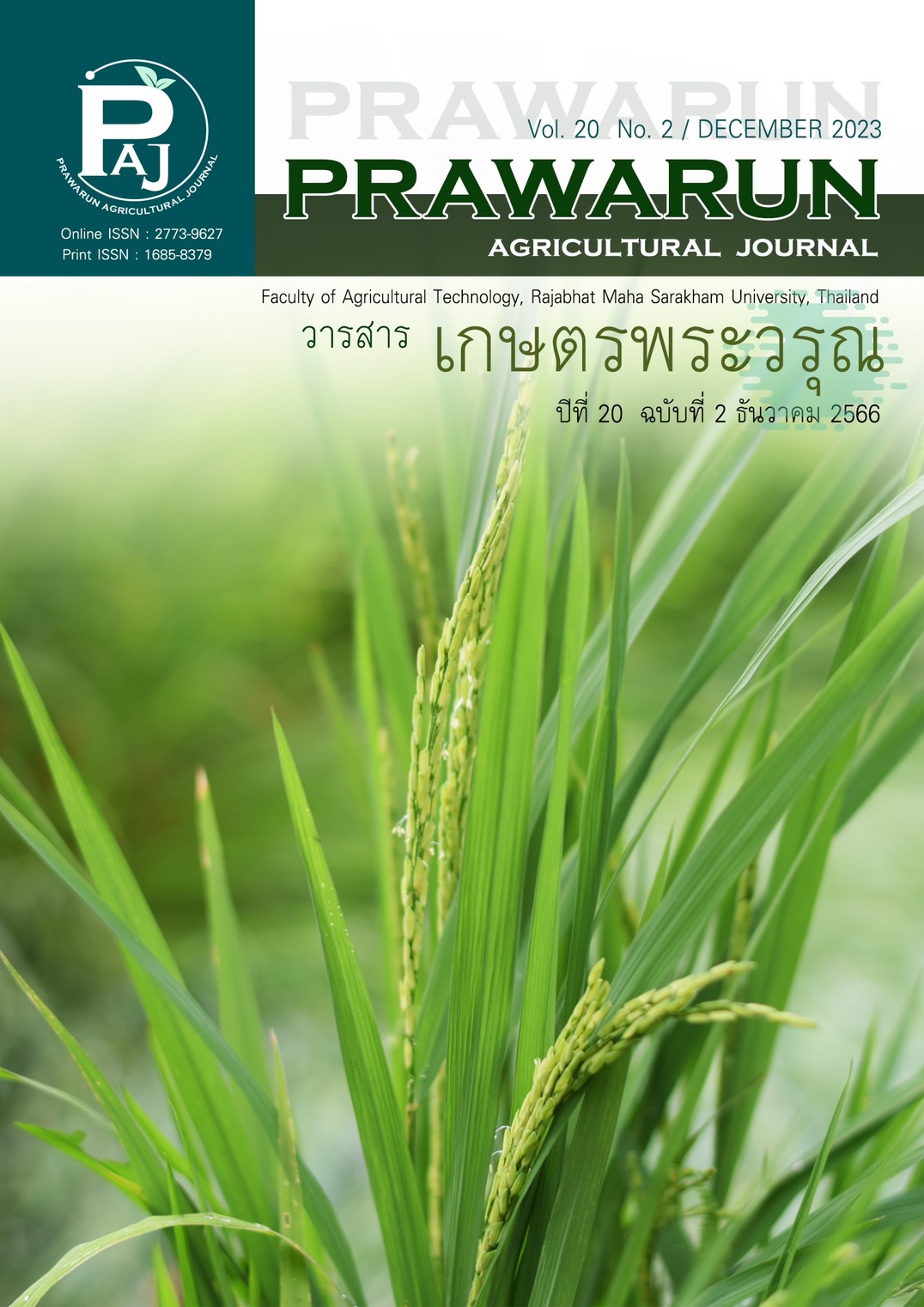การพัฒนาผลิตภัณฑ์น้ำพริกปลานิลเค็ม
Main Article Content
บทคัดย่อ
ปลานิลเค็มเป็นผลิตภัณฑ์ของวิสาหกิจชุมชนรอบเขื่อนลำปาวที่นิยมแปรรูปจากปลานิลที่เลี้ยงในกระชังและตายแบบกะทันหันเนื่องจากการเปลี่ยนแปลงของภูมิอากาศ แต่ยังมีราคาจำหน่ายค่อนข้างต่ำ งานวิจัยนี้มีวัตถุประสงค์เพื่อพัฒนาผลิตภัณฑ์น้ำพริกปลานิลเค็มเพื่อเพิ่มมูลค่า โดยศึกษาสูตรต้นแบบในการผลิต การพัฒนาสูตรต้นแบบ การทดสอบผู้บริโภค และการศึกษาคุณภาพของผลิตภัณฑ์สุดท้าย ผลการทดลองพบว่า สูตรที่พัฒนาได้ของน้ำพริกปลานิลเค็มประกอบด้วยเนื้อปลานิลเค็มทอด พริกชี้ฟ้าแห้ง พริกขี้หนูแห้ง หอมเจียว กระเทียมเจียว น้ำมะขามเปียก น้ำตาลทราย น้ำตาลปี๊บ และผงปรุงรส ร้อยละ 36.85 3.68 3.68 12.29 12.29 19.66 4.18 4.91 และ 2.46 ตามลำดับ มีคะแนนความชอบเฉลี่ยในทุกคุณลักษณะอยู่ที่ระดับชอบเล็กน้อยถึงชอบปานกลาง (6.98-7.71 คะแนน) ผู้บริโภคให้การยอมรับต่อผลิตภัณฑ์ร้อยละ 97.50 และตัดสินใจซื้อร้อยละ 87.00 น้ำพริกปลานิลเค็มที่พัฒนาได้มีค่าความสว่าง (L*) ค่าสีแดง (a*) และค่าสีเหลือง (b*) เท่ากับ 36.97, 9.99 และ 10.33 ตามลำดับ มีค่า water activity (aw) เท่ากับ 0.59 ปริมาณความชื้น โปรตีน ไขมันทั้งหมด เถ้า คาร์โบไฮเดรต และค่าพลังงานของน้ำพริกปลานิลเค็มที่พัฒนาได้มีค่าเท่ากับ ร้อยละ 10.77 14.84 18.64 6.18 49.57และ 425.40 Kcal/100 g ตามลำดับ มีปริมาณจุลินทรีย์ทั้งหมด (6.50 x 102 CFU/g) และยีสต์และรา (< 10 CFU/g) ไม่เกินเกณฑ์ที่มาตรฐานผลิตภัณฑ์ชุมชน: น้ำพริกผัด (มผช.321/2556) และน้ำพริกป่นแห้ง (มผช. 130/2556) กำหนด มีต้นทุนวัตถุดิบเท่ากับ 87.60 บาทต่อกิโลกรัม ผลิตภัณฑ์น้ำพริกปลานิลเค็มที่พัฒนาได้จึงเป็นแนวทางหนึ่งในการเพิ่มมูลค่าและสร้างผลิตภัณฑ์ใหม่ที่เป็นเอกลักษณ์ให้กับชุมชน
Article Details
เอกสารอ้างอิง
Andrews, W. (1992). Manual of food quality control. 4. Rev. 1. Microbiological analysis. Food and drug administration. FAO Food and Nutrition Paper, 14(4 Revis 1), 1-338
Association of Official Analytical Chemists (AOAC). (2019). Official methods of analysis (21st ed.). Washington, D.C.: Association of Official Analytical Chemists.
Association of Official Analytical Chemists (AOAC). (2012). Official methods of analysis (19th ed.). Washington, D.C.: Association of Official Analytical Chemists.
Bacteriological Analytical Manual (BAM). (2001). Yeast, molds and mycotoxins. Assessed July 25, 2023. Retrieved from https://www.fda.gov/food/laboratory-methods-food/bam-chapter-18- yeasts-molds-and-mycotoxins
Chamchan, R., Charoenkiatkul, S., Thiyajai, P., Suwanwattana, W., Suttisansanee, U., Srichamnong, W., & On-nom, N. (2019). Development of dried chili paste with added indigenous herbs from conserved area of plant genetic conservation at Kanchanaburi Province. Walailak Journal of Science and Technology (WJST), 16(Spec. issue 5), 361-368. doi: 10.48048/wjst.2019.6288
Chaveesuk, R., & Jitareetep, C. (2018). Chili paste culture in Bangkok metropolis. KnE Life Sciences, 4(2), 136-145. doi: 10.18502/kls.v4i2.1665
Chumsree, P. (2016). The Product development of tamarind chili paste supplementary preserved catfish. APHEIT Journals, 5(2), 48-55. (in Thai)
Chinabhark, K., Sribuathong, S., Jitwarin, T., & Jitwarin, L. (2022). Effect of Nile tilapia (Oreochromis niloticus) bone on quality of dried herbal chili paste. KMUTT Research & Development Journal, 45(3), 327-339. doi: 10.14456/kmuttrd.2022.19 (in Thai)
Department of Medical Sciences and National Bureau of Agriculture Commodity and Food Standards. (2003). Compendium of methods for food analysis. Nonthaburi, Thailand: Department of Medical Sciences, Ministry of Public Health, Thailand. (in Thai)
Fisheries Development Policy and Planning Division. (2021). Fisheries statistic of Thailand 2019 (Document No. 2/2021). Bangkok, Thailand: Department of Fisheries, Ministry of Agriculture and Cooperatives. (in Thai)
Inprasit, K., Chookaew, L., Suksawad, J., & Chuenwatthana, S. (2022). Physicochemical properties and capsicinoids content of Thai chili cultivars used in southern sour curry paste (Kaeng Som). Bulletin of Applied Sciences, 11(11), 121-132. doi: 10.60136/bas.v11.2022.140 (in Thai)
Insumran, Y., Jansawang, N., Jenakoon, S., Sanwung, S., & Ruangchai, N. (2022). Development of traditional chili paste from freshwater algae (Spirogyra neglect (Hassall) Kützing). Prawarun Agricultural Journal, 19(1), 88-94. doi: 10.14456/paj.2022.11 (in Thai)
Kosorn, K. (2021). Tilapia helps prevent cardiovascular disease. Accessed June 1, 2023. Retrieved from https://nutrition2.anamai.moph.go.th/th/antifakenews/download?id=74772&mid=35692&mkey=m_document&lang=th&did=24236 (in Thai)
Lawless, H. T., & Heymann, H. (1998). Sensory evaluation of food: principles and practices. New York:Chapman & Hall.
Maeban. (2018). Nam Prik Ngoen Lan. Bangkok, Thailand: Maeban Publisher. (in Thai)
Maepakdee, S., Rattanasuwan, P., Krasaechon, N., & Yuenyongputtakul, W. (2014). Enrichment of protein and iron in snack products using tuna blood power. Journal of King Mongkut's University of Technology North Bangkok, 24(1), 168-177. (in Thai)
Manarote, A., Tubbiyam, P., Khuaikhoen, W., & Phurahong, B. (2019). Partial substitution of young tamarind by karonda in Nam Prik Makham product. RMUTP Research journal, 13(1), 139-148. (in Thai)
Pongsetkul, J., & Benjakul, S. (2021). The use of sodium benzoate on shelf-life and quality attributes of dried chili fish paste stored in different packaging containers. Foods, 10(8), 1082.doi: 10.3390/foods10081802.
Pornchaloerm, P., & Rattapanone, N. (2023). Scoville heat unit. Accessed July 25, 2023. Retrieved from https://www.foodnetworksolution.com/wiki/word/2246/scoville-heat-unit-สโกวิลล์. (in Thai)
Phugan, P., Inket, S., Pramai, P., & Singsom, S. (2020). Development of stir-fried chilli paste from herb. Rajabhat Rambhai Barni Research Journal, 14(1), 131-138. (in Thai)
Sirilerk, C. (2018). The product development of “Nam-Prik Pla Nil Yong” (dried shredded Nile tilapia chili paste) supplemented with calcium from the bone of Nile tilapia (Tilapia nilatatiea). Vocational Education Central Region Journal, 2(1), 56-62. (in Thai)
Somthawil, S., & Sriwatta, S. (2012). The use of just about right scales in reformulation of Thai northern style sausage., Proceedings of the 50th Kasetsart university annual conference: agro-industry, Kasetsart university (pp. 167-174). Bangkok, Thailand: Kasetsart University. (in Thai)
Tayeh, N., Sukjantra, J., Na Nakorn, K., & Kamaelae, R. (2022). Development of stir-fried chili paste from Plasom Pla-nil (fermented tilapia). YRU Journal of Science and Technology, 7(3), 1-8. (in Thai)
Thai Community Product Standard. (2013). Dried chili paste (TCPS. 130/2013). Bangkok, Thailand: Ministry of Industry. (in Thai)
Weiss, E. A. (2002). Spice crops. New York, United States: CABI publishing.


